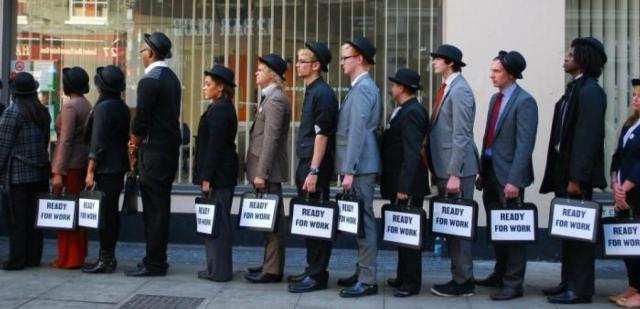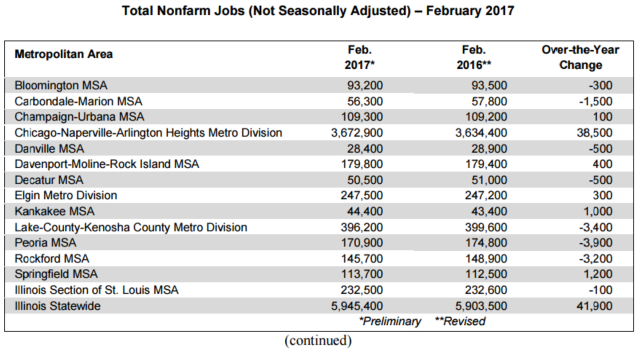 Many downstate metros continue to report job losses
Many downstate metros continue to report job losses
CHICAGO – All but one of Illinois’ metropolitan (metro) areas experienced decreases in their over-the-year unemployment rate. Six of the metro areas had increases in nonfarm jobs, eight reported declines, according to preliminary data released today by the U.S. Bureau of Labor Statistics (BLS) and the Illinois Department of Employment Security (IDES).
Get The Latest News!
Don't miss our top stories and need-to-know news everyday in your inbox.
“More than half of the metro areas statewide lost jobs,” said IDES Director Jeff Mays. “Of all the nonfarm jobs gained over the last year, less than 10 percent were outside of the Chicago metro area.”
 Illinois businesses added jobs in six metro areas, in which the largest increases were seen in: Kankakee (+2.3 percent, +1,000), and Springfield (+1.1 percent, +1,200). Total nonfarm jobs in the Chicago-Naperville-Arlington Heights Metro Division increased (+1.1 percent or +38,500). Illinois businesses lost jobs in eight metro areas including Carbondale-Marion (-2.6 percent, -1,500), Peoria (-2.2 percent, -3,900), Rockford (-2.1 percent, -3,200). The industry sectors recording job growth in the majority of metro areas were: Education and Health Services (ten of 14), Professional and Business Services (nine of 14) and Financial Activities (eight of 14).
Illinois businesses added jobs in six metro areas, in which the largest increases were seen in: Kankakee (+2.3 percent, +1,000), and Springfield (+1.1 percent, +1,200). Total nonfarm jobs in the Chicago-Naperville-Arlington Heights Metro Division increased (+1.1 percent or +38,500). Illinois businesses lost jobs in eight metro areas including Carbondale-Marion (-2.6 percent, -1,500), Peoria (-2.2 percent, -3,900), Rockford (-2.1 percent, -3,200). The industry sectors recording job growth in the majority of metro areas were: Education and Health Services (ten of 14), Professional and Business Services (nine of 14) and Financial Activities (eight of 14).
Not seasonally adjusted data compares February 2017 with February 2016. The not seasonally adjusted Illinois rate was 5.5 percent in February 2017 and stood at 12.2 percent at its peak in this economic cycle in January 2010. Nationally, the not seasonally adjusted unemployment rate was 4.9 percent in February 2017 and 10.6 percent in January 2010 at its peak. The unemployment rate identifies those who are out of work and looking for work, and is not tied to collecting unemployment insurance benefits.
Metro East Highlights
Help Wanted
Area employers advertised for 4,700 openings in February and approximately 81 percent sought full-time employment, according to Help Wanted OnLine data compiled by the Conference Board. It is a global, independent business membership and research association. Employers actually need more workers than the help wanted ad indicates because some industries, such as construction, typically do not advertise job openings.
The February 2017 unemployment rate for the Illinois Section of the St. Louis Metropolitan Statistical Area was 5.2 percent, a decrease of (-1.4) from the February 2016 rate of 6.6 percent. The data is not seasonally adjusted.
The number of employed individuals increased by 6,130 to 328,708 in February 2017 from322,578 in February 2016. The labor force increased by 1,329 to 346,724 in February 2017 from 345,395 in February 2016. In February 2017, there were 18,016unemployed people in the labor force. This is a decrease of 4,801 compared to the February 2016 total unemployed, 22,817.
Over the year, nonfarm payrolls decreased by (-100).
Employment increased in Transportation, Warehousing and Utilities (+700), Leisure and Hospitality (+500) and Professional and Business Services (+300) in February 2017 compared to February 2016.
Decreases in employment over the year included Manufacturing (-500), Mining and Construction (-400), Wholesale Trade (-200), Financial Activities (-200), Retail Trade (-100), Information (-100), and Educational and Health Services (-100).
Government and Other Services employment was unchanged over the year.
Note:
Monthly 2016 unemployment rates and total non-farm jobs for Illinois metro areas were revised in February 2017, as required by the U.S. Dept.of Labor, Bureau of Labor Statistics(BLS).Comments and tables distributed for prior metro area news releases should be discarded as any records or historical analysis previously cited may no longer be valid.LWA— Local Workforce Area 21 is composed of Calhoun, Greene, Jersey, Macoupin, Montgomery, Morgan, Scott and Shelby Counties.
LWA— Local Workforce Area 22 is composed of Bond and Madison Counties.
LWA— Local Workforce Area 24 is composed of Clinton, Monroe, Randolph, St. Clair and Washington Counties.


More like this:
